Charles of the Ritz
Continued to: Charles of the Ritz (1936-1945)
In December, 1910, the Ritz-Carlton Hotel opened on the corner of Madison Avenue and 46th Street, New York. Included in its facilities was a barber shop for men and a hairdressing parlour for women, both run by Charles H. Ritz. As well as barbering, hairdressing, and manicuring services, Ritz sold cosmetics and toiletries through his shops, some manufactured under his own label. Those that I know of are Ritz Cold Cream, Ritz Cuticle Cream, and Ritz Hair Tonic.
Charles Jundt
In 1919, Ritz sold his ladies’ hair dressing establishment, with its equipment and good will, to his employee Charles Jundt. Jundt was born in Alsace Lorraine, then a part of Germany. He moved to Paris to work as a hairdresser but was living in London, England by 1902. In 1914, he emigrated to the United States becoming an American citizen in 1921 and worked in the beauty salon of H. Simpson on 5th Avenue, Manhatten for two years before coming to work for Ritz in the Ritz-Carlton Hotel. He was apparently friendly with Elizabeth Arden and was reported to have styled her hair during the opening of his Boston salon. Jundt’s daughter Ethel was employed by Arden in her 5th Avenue salon.
Jundt expanded the business, opening additional salons and increasing the company’s product range to include: Hair Frictions in L’Opera, D’Abre, Ishah and Mondeuse perfumes; Tar, Pine and Henna Shampoos; Tonics for Dry and Oily Hair; Dandruff Lotions No. 1 (mild) and 2 (strong); Special Oil; and Henna Leaves, Camomile, Blueing, and Water Waving Lotions. These were sold through various retail outlets as well as the eleven Charles of the Ritz salons at the Ritz-Carlton Hotel, Plaza Hotel, Madison Hotel, Mayfair House, Park Chambers, Barclay Hotel, and Ritz Tower in New York; the Ritz-Carlton Hotel in Atlantic City, New Jersey; the Ritz-Carlton Cloisters in Boca Raton, Florida; and the Ritz-Carlton Hotel in Boston, Massachusetts.
In 1928, Charles of the Ritz incorporated and filed an application for a trademark that was granted in 1930. In September, 1928, the company launched a complete line of cosmetics, sold through retail outlets and Charles of the Ritz salons, backed by a US$250,000 advertising campaign.

Above: 1929 The Toiletries of Charles of the Ritz.
To handle the increased production, new manufacturing facilities were opened at 9-11 University Place, New York and John H. Hershman was hired as the company’s general manager (AP&EOR, 1928, p. 375). University Place would subsequently become the base for Charles of the Ritz Distribution, Inc., the sales arm of Charles of the Ritz.
All this cost a good deal of money, much of it may have come from, or have been organised by Charles H. Goddard who is listed, along with Charles Jundt and his wife Anna, on the Charles of the Ritz trademark application filed in 1928.
Charles H. Goddard
Charles Harrison Goddard was a promotor with a colourful history in newspapers and mining. After arriving in New York he became very wealthy, first from organising the American Druggists’ Syndicate (ADS), a druggist cooperative founded in 1905, then from selling real estate in Great Neck, Long Island, New York in the 1920s. Goddard was also the person that brought George W. Luft [1869-1939], the originator of Tangee, to New York.
See also: Tangee
Exactly when Goddard became involved with Charles of the Ritz is unknown to me. It was certainly no later than 1927 but was likely to have been earlier than this. There may have been a family connection as Jundt’s daughter, Ethel Marguerite (Margaret) Jundt [1903-1978], married Charles Harold Goddard [1895-1986] in 1925.
Goddard seems to have been positioning Charles of the Ritz for immediate sale. In 1928, negotiations were started with Terminal Barber Shops, Inc. for the sale of Charles of the Ritz for about US$1 milllion. An agreement between the two companies was reached by 1929 but the stock market crash of October, 1929 postponed its execution. Negotiations continued but had been abandoned by 1933 (Owen, 1940, pp. 1182-1183). By then Goddard was dead, having died from a stroke on the S. S. Wisconsin sailing to New York in 1930. He had been living abroad for the previous three years, chiefly in Mentone on the French Riviera.
After the negotiations with Terminal Barber Shops stalled, and no other buyer was evident, Charles of the Ritz set about expanding its operations, establishing salons in new department stores opened by B. Altman & Co. in the 1930s.
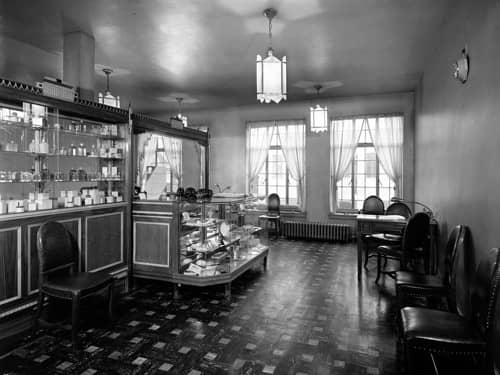
Above: 1932 Waiting room in the Charles of the Ritz salon in the Altman department store in White Plains, New York (Museum of the City of New York).
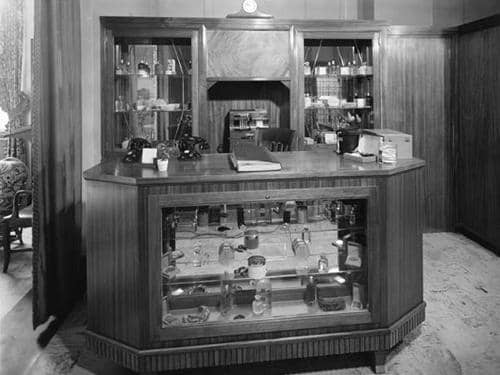
Above: 1932 Front desk of the Charles of the Ritz salon in the Altman department store in East Orange, New Jersey (Museum of the City of New York).
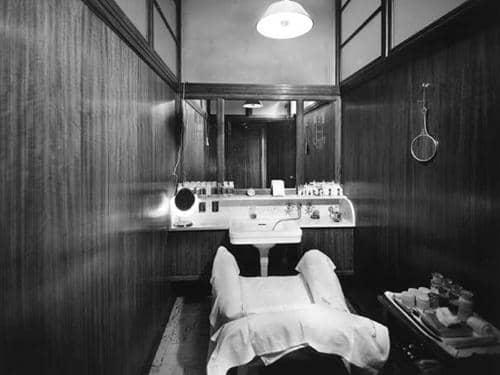
Above: 1932 Treatment room in the Charles of the Ritz salon in the Altman department store in East Orange, New Jersey (Museum of the City of New York).
Charles of the Ritz also began creating subsidiaries in other countries, starting with Canada in 1933, the same year that it bought the rights to Velo-Derma – an anti-wrinkle skin cream developed by the German chemist Marcel von Wertaur in 1930 – from Edwin Wasey & Co. Charles of the Ritz created new companies, Velo-Derma Corp., Ltd. and Velo-Derma Distributors, Ltd. to make and market Velo-Derma. It also took over the Dr. von Wertaur Laboratories which now operated as Dr. von Wertaur Laboratories, Ltd.
Otto J. Cohen
A person of significance to the company during this development was Otto J, Cohen [1888-1979]. He had joined Charles of the Ritz in 1927, becoming one of its vice presidents. As the brother of Syma Cohen, a.k.a. Syma Busiel [1891-1990], he had previously been associated with the Lady Esther Company and was its president until 1925 when he sold his stake in that business.
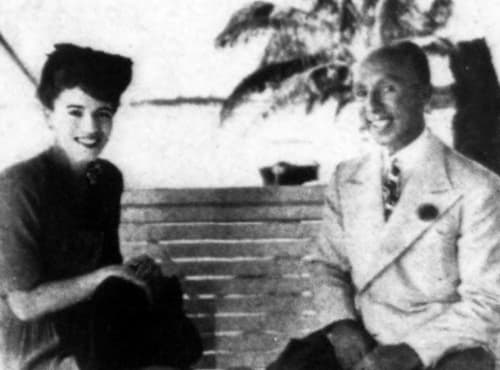
Above: 1942 Erna Mendelson and Otto Cohen on honeymoon following their wedding. Both had previous marriages.
Cohen’s knowledge of the cosmetics business was very extensive. He is credited with developing both the Rejuvenescence Cream Ritz and the Charles of the Ritz Individual Powder Blending Service, placing Charles of the Ritz cosmetics into department stores, and training its sales people, so his contribution to the company was substantial.
See also: Lady Esther
Products
The Charles of the Ritz range introduced in 1928 was comprehensive and included products for what the company described as the four vital essentials of ever-youthful beauty: hair, eyes, complexion and hands. Most of the items had the word Ritz in their name, an idea that was extended to products that had existed before 1928. For example, Dandruff Lotion No. 2 became Dandruff Lotion No. 2 Ritz.
Hair-care
Charles of the Ritz had started as a women’s hair salon and this continued to be an important source of income for the business. The company kept abreast of new developments in permanent and finger waving and continued to sell an extensive range of its own shampoos, hair tonics, brilliantines and temporary hair colourants.

Above: 1932 Hairdressing cubicle in the Charles of the Ritz salon in the Altman department store in White Plains, New York. Note the permanent hair machine (left) (Museum of the City of New York).
Skin-care
Charles of the Ritz developed skin-care routines for normal, dry and oily skin types. These followed the standard pattern of ‘cleanse, tone and foundation or feed’ that was in wide usage at the time.
In the morning, the skin was first cleansed with a cleanser selected by skin type: Cleansing Cream Ritz (normal skins), Massage Cream Ritz (dry skins), and Lemon Cleansing Cream (oily skins). The skin was then toned with Skin Tonic Riz to brace it and remove the last traces of cleanser.
Cleansing Cream Ritz: “A thorough and effective cleanser, suitable for all types of skins. The favorite of those who like a liquefying cleansing cream that melts upon touching the face. Especially recommended for normal or oily skins, since it has no nourishing properties, but is merely an efficient and very delightful cleansing agent.”
Massage Cream Ritz: “An effective cleanser, refreshing and soothing. Recommended especially for the dry skin as it is made of nourishing as well as cleansing oils.”
Lemon Cleansing Cream: “The perfect cleanser for a sluggish, sallow, or dark and oily skin. Both stimulating and mildly bleaching. Does not increase the skin’s natural oils.”
Skin Tonic Ritz: “Tones the skin and stimulates the circulation; awakens each sluggish cell. A real tonic for the skin, absolutely indispensable in every treatment; leaves the skin fresh and glowing.”
After cleansing and toning the skin was ready for foundation, either Skin Bloom Ritz (normal and dry skins) or Astringent Ritz (oily skins).
Skin Bloom Ritz: “A luminous protective foundation for the normal or dry skin. Gives a lovely mat finish. Rouge goes on more smoothly, powder clings longer.”
Astringent Ritz: “Recommended especially for the oily and acne blemished skin. Corrects excess oiliness, refines the skin and closes the pores.”
A night, foundation was replaced with a skin food, either Skin and Tissue Builder Ritz (for normal skins), Requisite Cream Ritz for Dry Skin, or Requisite Cream Ritz for Oily Skin.
Skin and Tissue Builder Ritz: “Supplies those natural youthifying oils which our modern mode of living so quickly rob from the skin. Keeps the skin supple and soft.”
Requisite Cream Ritz for Dry Skin: “A luxurious and effective nourishing cream for the dry skin. Special ingredients make this a real corrective preparation.”
Requisite Cream Ritz for Oily Skin: “The ideal corrective for excess oiliness, acts as an astringent upon the oil glands, tones the skin and preserves its youthful elasticity.”
There were also specialist skin-care cosmetics for women with Sensitive Dry Skin, Dry Skin with Blackheads, Oily Skin with Blackheads, and Oily Skin with Acne. For example, Sensitive Dry Skin cleansed with Sensitive Skin Cleanser Ritz and used Velvet Texture Cream Ritz at night.
Sensitive Skin Cleanser Ritz: “A delightful cleansing milk, ideal for dry sensitive skin. This milky liquid seeps gently into the depths of the pores, freeing them of all dirt and at the same time soothing and lubricating the skin.”
Velvet Texture Cream Ritz: “Made of rich rare oils and nourishing unguents. Its faithful use will preserve or restore the satin smoothness to a dry, sensitive skin.”
Also see the booklet: Beauty in the Modern Mode (1932)
To erase lines and wrinkles, Charles of the Ritz suggested Muscle Oil Ritz and Anti-Wrinkle Cream Ritz. These would ‘feed and strengthen’ the underlying facial muscles, firm the skin and reduce facial lines. Stimulation Cream Ritz, a type of circulation cream, could be used occasionally to boost skin circulation. Again, all ideas widely promoted at the time.
Muscle Oil Ritz: “A rich bracing oil that strengthens sagging muscles and supports relaxed tissues.”
Anti-Wrinkle Cream Ritz: “Rich, nourishing oils make Anti-Wrinkle Cream Ritz the ideal cream for the dry or lined skin.”
Stimulation Cream Ritz: “An ideal twice-a-week treatment for every woman over thirty. lt banishes that weary ‘six o'clock look’ and gives your face a morning freshness.”
See also: Skin Tonics, Astringents and Toners, Muscle Oils, Circulation Creams and Skin Foods
Other skin-care products included bleaches, pore pastes, sunburn creams, and masks.
Bleach Cream Ritz: “An effective bleach treatment for the tanned or freckled skin. Ideal also for the woman who wants a fairer, whiter and more delicately transparent skin.”
Sunburn Cream Ritz: “An ideal cream for the outdoor woman. Smoothed into the skin before exposure lo the sun, it will prevent painful burning and insure a lovely, golden tan.”
Sunstick Ritz: “For the sun-worshiping Modern Woman. Used before exposure lo the sun, it insures a glorious golden tan and prevents painful burning and unsightly tan.”
Lemon Masque Ritz: “It is a simple, wholesome beautifier. It stimulates the circulation, exercises the cells and revitalizes and exhilarates the skin.”
Plastique Vegetable Masque Ritz: “A scientific preparation which consolidates the tissues, firms flabby muscles, stimulates the circulation and increases the activity of the skin cells. It clarifies the skin and enkindles new beauty.”
Later additions included Pore Wash Ritz (1934), Ritztone Sun Oil (1935), and Polar Cream Ritz (1936).
Special rejuvenating treatment
This treatment was said to counteract gravity that was ‘constantly pulling the muscles of the face down towards the earth’ resulting in a sagging of the contour and the loss of youthful firmness. It was based on Rejuvenescence Cream Ritz, a skin-care cosmetic that became a flagship product for Charles of the Ritz but also brought it into conflict with the U.S. Federal Trade Commission (FTC). I do not know exactly when it was developed but it was no later than 1932. As mentioned earlier, Otto Cohen claimed to have formulated it.
Rejuvenescence Cream Ritz was said to contain ‘an organic compound made of substances extracted from living tissues’. Ingredient lists from later products suggest that this was probably lanolin.
Rejuvenescence Cream Ritz: “It supplies the skin with the precious youth giving element essential to young skins. It is absorbed by the skin immediately, leaving no greasy film on the surface. Its basic elements penetrate to the derma or true skin and revivify the tissues, giving the skin new life and vitality.”
The cream was considered suitable for all skin types and was to be used in both morning and evening routines. However, Charles of the Ritz recommended a Plastique Vegetable Masque Treatment applied warm under a rubber mask every other day. The main benefit form this treatment probably came from the perspiration that accumulated under the mask during the 15-20 minute treatment. This would plump up the surface skin cells and reduce the visible appearance of lines in a similar fashion to a paraffin wax treatment.
Plastique Vegetable Masque Ritz: “A scientific preparation which consolidates the tissues, firms flabby muscles, stimulates the circulation and increases the activity of the skin cells. It clarifies the skin and enkindles new beauty.”
See also: Paraffin Wax Treatments
In 1934, the Plastique Vegetable Masque Ritz was replaced with Rejuvenescence Masque. This did away with the rubber mask making the Rejuvenescence Treatment a lot simpler.
Rejuvenescence Masque: “[A] boon for every woman in search of youth and loveliness. Its ingredients are so potent that a single treatment shows amazing results.”
Eyes
The Charles of the Ritz eye treatment involved bathing the eyes every morning and night with Eye Lotion Ritz using an eye cup or medicine dropper and nourishing the area around the eye each night with Eye Cream Ritz.
Eye Lotion Ritz: “This soothing and refreshing lotion strengthens the eyes, relieves eye strain and keeps the eyes clear and radiant.”
Eye Cream Ritz: “Nourishes the delicate tissue about the eyes; banishes crows’-feet and lines about the eyes.”
Hands
Women could use Hand Cream Ritz or Skin and Tissue Builder Ritz under gloves at night to soften their hands, and Rose Hand Lotion Ritz during the day. There was also Lemon Hand Lotion Ritz to whiten them and Nicotine Remover Ritz to remove nicotine and other stains such as ink from fountain pens.
Hand Cream Ritz: “Supplied the extra oils needed by the hands.”
Lemon Hand Lotion Ritz: “Makes the hands creamy white and smooth.”
Rose Hand Lotion Ritz: “Should be used after every washing of the hands. It keeps the hands soft and smooth and delicately perfumed.”

Above: 1932 Manicure stations in the Charles of the Ritz salon in the Ritz Tower, New York (Museum of the City of New York).
Charles of the Ritz sold a complete manicure range which included: Cuticle Cream Ritz, Cuticle Oil Ritz and Cuticle Remover Ritz to treat the nail cuticle; Nail Whitener Ritz (cream or powder) to whiten the free edge of the nail; Eclat Liquid Powder Ritz to buff the nail plate; and Nail Enamel Ritz and Nail Enamel Remover Ritz.
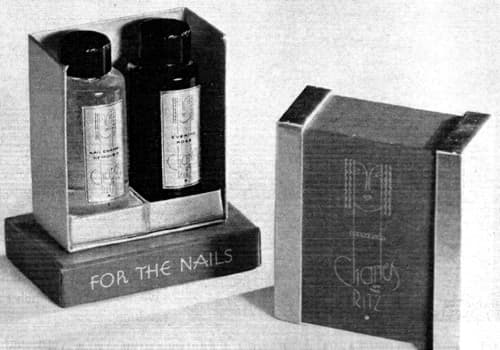
Above: 1933 Nail Enamel Ritz (Evening Rose) and Nail Enamel Remover Ritz.
Nail Enamel Ritz: “Gives a beautiful bright lustre that retains its brilliance for at least a week without cracking, peel;ing or fading. It has no odor and dries quickly. Made in lovely tints to match your mood or costume.” Shades: Blood Red, Evening Rose, Rose Bloom, Rose Tint, Scarlet Lake, Carmine, Ivory Glow, and Plain.
Make-up
Charles of the Ritz sold a complete range of make-up which included foundations, face powders, rouges, lipsticks, and eye make-up.
Foundation
The recommended make-up routine suggested beginning with a liquid or cream foundation. The previously mentioned Skin Bloom Ritz or Astringent Ritz could be used but women who wanted extra colour could select Make-up Lotion Ritz.
Make-up Lotion Ritz: “An excellent powder foundation for all skins; lovely for the neck and arms in the evening. It gives a soft natural finish.” Shades: Phantasy, Deep Phantasy, Naturelle, Rachel, Deep Rachel, Cream, Beachtan, and White.
Although Make-up Lotion Ritz was recommended for the evening and Skin Bloom Ritz for the day, it is likely that some women broke this rule and used Make-up Lotion Ritz during the day for extra coverage.
Face Powder
Charles of the Ritz face powders also came in loose and compact forms. Poudre Phantasy Ritz was formulated in the same shades as Make-up Lotion Ritz while the Compact Powder shade range was limited to Natural, French Rachel, Cream Rachel, Phantasy, and Beachtan shades.
Poudre Phantasy Ritz: “Fine, pure and clear, this powder is a favourite with everyone. It veils the skin in beauty and gives a naturalness that is impossible with a powder less fine and perfect.” Shades: Phantasy, Deep Phantasy, Naturelle, Rachel, Deep Rachel, Cream, Opal, Beachtan, Apricot, White, and Green.
In addition to these set shade ranges, Charles of the Ritz also provided clients with a service that offered individually blended rouge and powder. Initially, this was only available to clients through Charles of the Ritz salons but the idea was later extended to department stores and other outlets. In later years it would become a major selling point for the company.
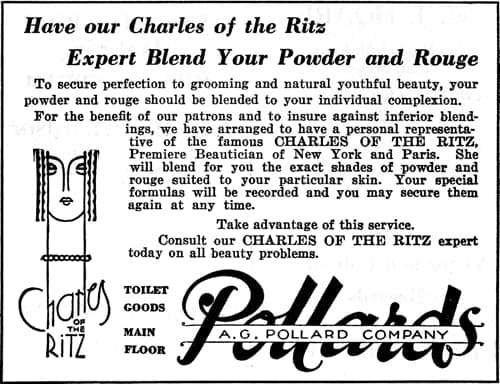
Above: 1928 Charles of the Ritz Powder Bar.
See also: Charles of the Ritz Powder Bars
Rouge and lipstick
Charles of the Ritz recommended a cream rouge – Light, Medium, Raspberry, Ruby, Dark, and Beachtan shades – be applied to complement the shape of the face.
For the oval face, place the rouge in a triangular form, high on the cheek bones. for the round face rouge should be applied on the cheek bones just beneath the eyes and close to the nose. do not shade too far out on the cheek, keeping the rouge close to the nose adds length to the face. For the long face, rouge should cover a larger surface. Apply close to the eyes and in a very wide triangle, extending from close to the nose outward toward the ear, but do not come too far down on the cheek for best results.
(Charles of the Ritz, 1932, pp. 29)
The company also made a loose and compact rouge in Clair, Medium, Geranium, Raspberry, and Beachtan shades with the compact rouge coming in individual compacts or in combination with compact powders, loose powders and lipsticks.
Charles of the Ritz lipsticks were sold as in silver cases, either as Lipstick Ritz in Light, Medium, Raspberry, Ruby Dark, and Beachtan shades or as Lipstick Paris Ritz in an automatic case in Clair, Foncé, Electric, and Pour le Soir shades.
Eye-make-up
Charles of the Ritz eye make-up included eyebrow pencils, mascara and eyeshadow. There was Eyebrow Pencil Ritz in Blonde, Brown, and Black shades; Lashique Ritz in Blonde, Blue, Brown, and Black shades; and Eye Shadow Ritz in Ashen Brown, Blue-Grey, Green, Violet, and Light Blue shades. Like many other companies of the time it also sold an eyelash grower and an eye lotion, the later to be used with an eye cup to sooth tired eyes.
Eyelash Grower Ritz: “Promotes the growth of lashes. Apply to the lashes each night before retiring.”
Eye Lotion Ritz: “A tonic as well as a beautifier for the eyes. Strengthens the eye nerves, relieves eye strain and keeps the eyes clear and sparking.”
Sale
Charles of the Ritz eventually found a buyer in 1936. The new president of Charles of the Ritz, Richard B. Salomon [1912-1994], reorganised the company and John Hershman retired from the firm. Sadly, Hershman committed suicide in the Hotel Knickerbocker in New York in 1938. He had been suffering from depression and had recently returned from Europe where he had been undergoing treatments from Austrian nerve specialists.
Timeline
| 1910 | Charles H. Ritz opens a hairdressing business in the Ritz-Carlton Hotel, New York. |
| 1919 | Charles Jundt buys the hairdressing business of Charles H. Ritz. |
| 1926 | Charles Jundt adopts the Charles of the Ritz brand. |
| 1928 | Charles of the Ritz incorporates; laboratory moves from East 41st Street to 9-11 University Place, New York. New Products: Charles of the Ritz cosmetics line. |
| 1930 | New salons opened in Chicago, Southampton, and New York. |
| 1932 | Charles of the Ritz Distributers Corporation founded in New York. New Products: Sensitive Skin Cleanser Ritz; Velvet Texture Cream Ritz; Make-up Lotion Ritz; and Lipstick Paris Ritz. |
| 1933 | The rights to Velo-Derma bought; Velo-Derma Company established. Charles of the Ritz (Canada) Ltd. established. |
| 1934 | New Products: Pore Wash Ritz; and Rejuvenescence Masque. |
| 1935 | New Products: Ritztone Sun Oil. |
| 1936 | Charles of the Ritz sold to Benjamin E. Levy. New Products: Polar Cream Ritz; and Throat Firming Cream. |
Continued to: Charles of the Ritz (1936-1945)
First Posted: 21st March 2017
Last Update: 30th August 2022
Sources
Charles of the Ritz. (1932). Beauty in the modern mode [Booklet]. New York: Author.
Obituary. (1930). Journal of the American Pharmaceutical Association, 19(11), 1269.
Owen, M.M. (1940). Reports of the United States board of tax appeals (Vol. 40).
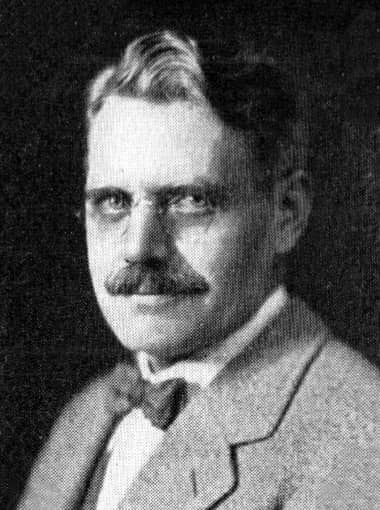
Charles Jundt [1880-1945].
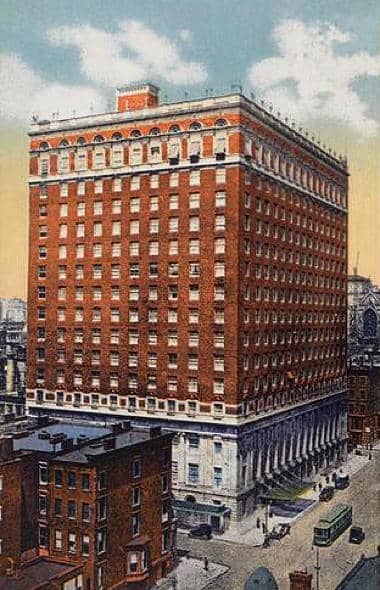
1911 Postcard image of the Ritz-Carlton. Designed by the architectural firm of Whitney Warren [1864-1943] and Charles Wetmore [c.1866-1941] the building was financed by Robert W. Goelet [1880-1941] who paid US$5,000 for use of the Ritz-Carlton name.

1918 Djer-Kiss Smirnoff’s Shampoo Powder, endorsed by Charles H. Ritz, Ritz-Carlton Hotel.
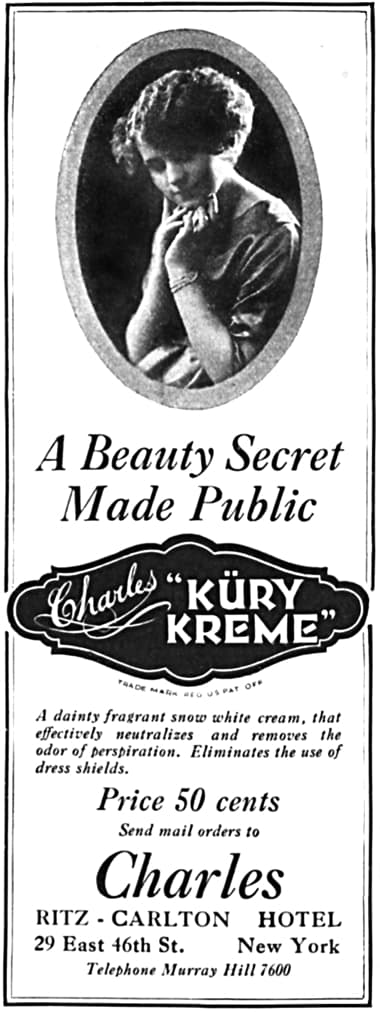
1922 Charles Küry Kreme Deodorant.

1926 Charles of the Ritz.
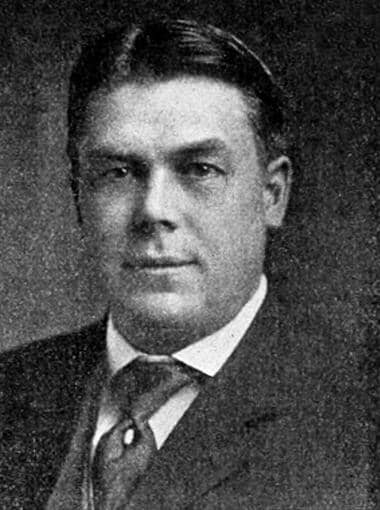
Charles Harrison Goddard [1871-1930].

John H. Hershman [c.1890-1938]. He was appointed general manager of Charles of the Ritz in 1928 becoming vice-president in 1930.

1928 Charles of the Ritz salons offering permanent waves. The Charles of the Ritz logo – designed by Gustav Boerge Jensen [1898-1954] – was first used as early as 1926.

1928 Charles of the Ritz cosmetics.
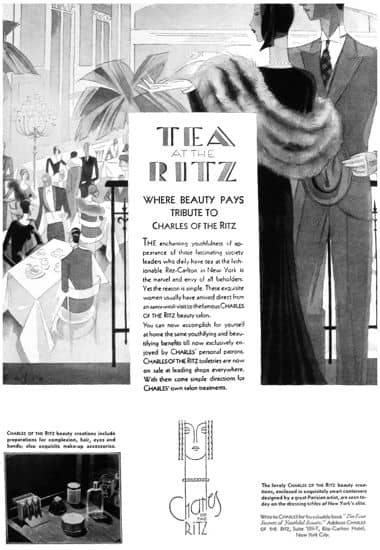
1929 Charles of the Ritz.

1929 Charles of the Ritz.
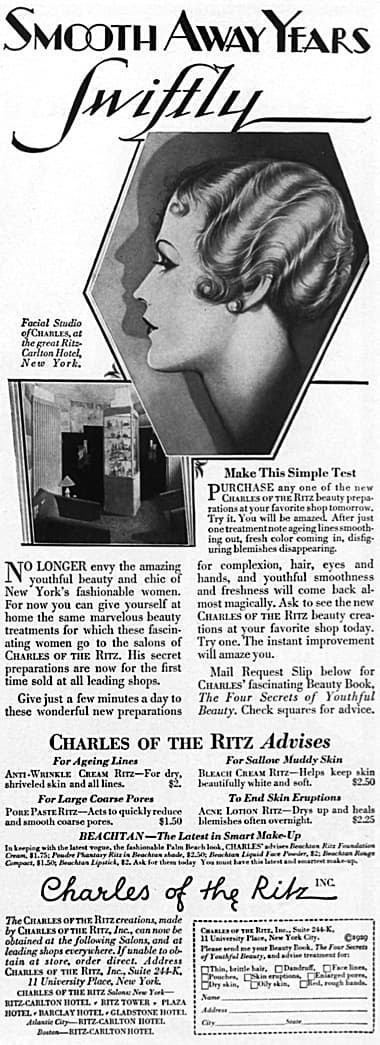
1929 Charles of the Ritz.
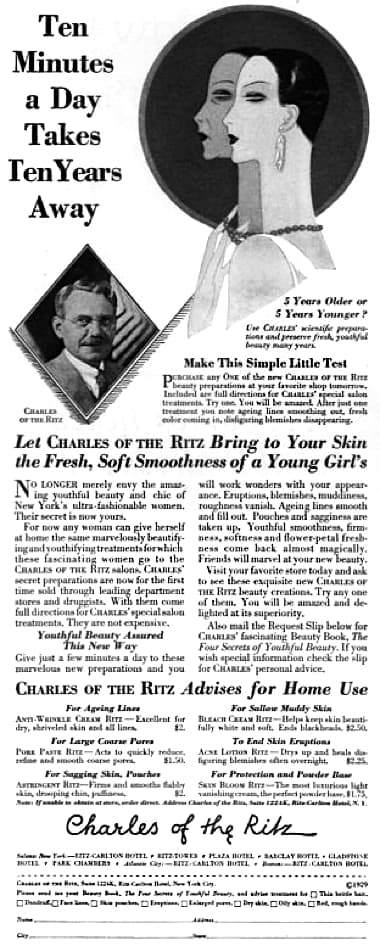
1929 Charles of the Ritz.
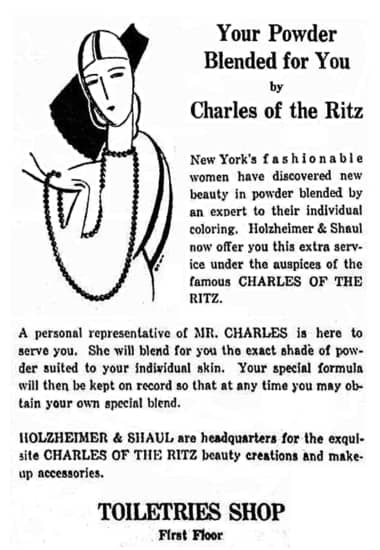
1930 Charles of the Ritz powder blending.
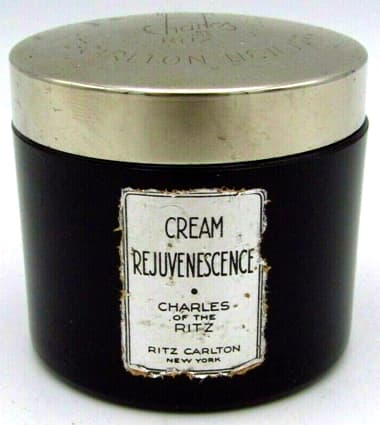
Charles of the Ritz Rejuvenescence Cream.
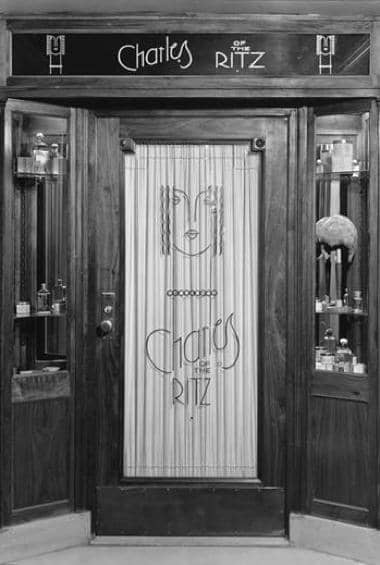
1932 Door to the Charles of the Ritz salon designed and built by William Grassgreen, Inc. in the Ritz-Tower, New York (Museum of the City of New York).
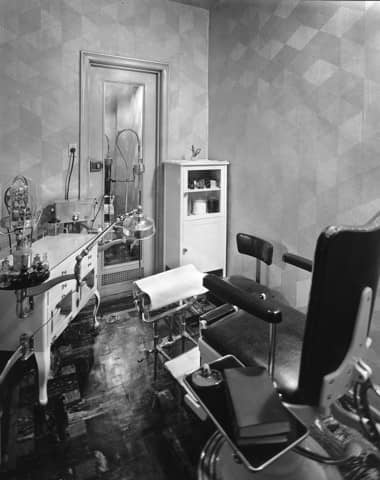
1932 Chiropodist room in the Charles of the Ritz salon, Ritz-Tower, New York (Museum of the City of New York).
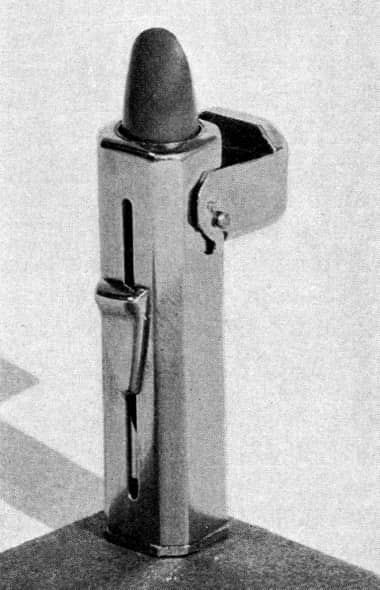
1933 Charles of the Ritz Automatic Lipstick in Clair, Electric, Foncé and Pour le Soir shades.
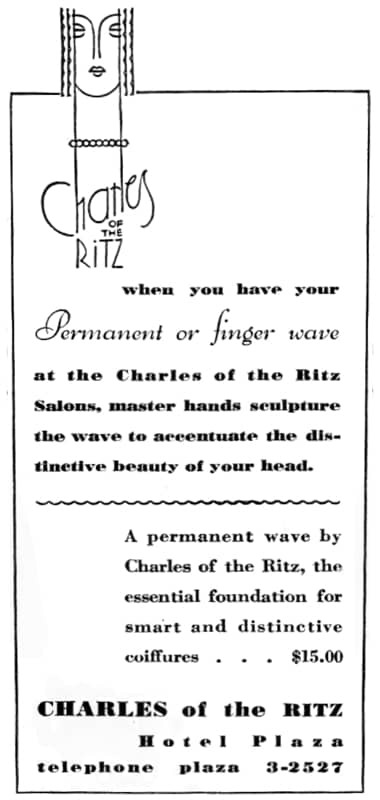
1934 Charles of the Ritz. After 1933 the company concentrated on promoting their hairdressing services particularly permanent waves.
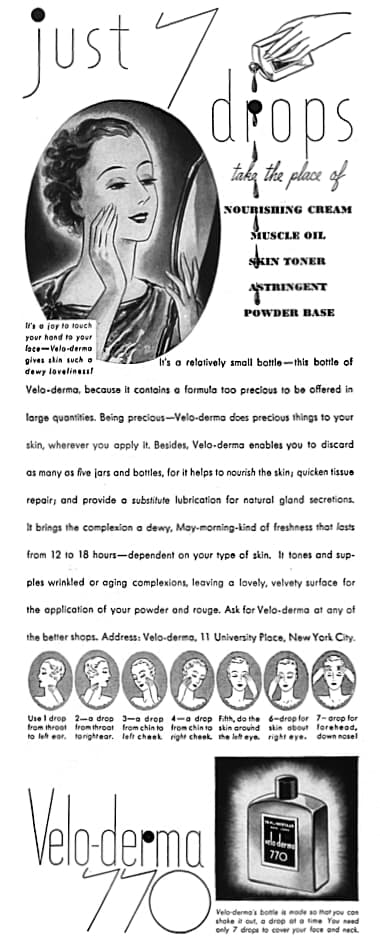
1934 Velo-Derma 770. Now owned by Charles of the Ritz.
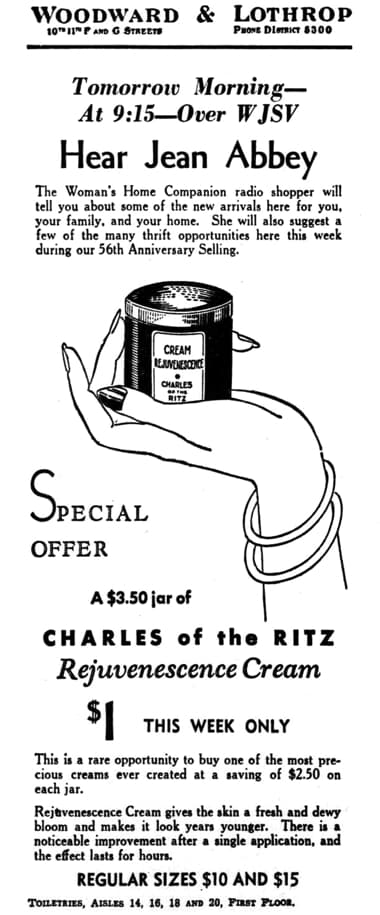
1936 Charles of the Ritz Rejuvenescence Cream.
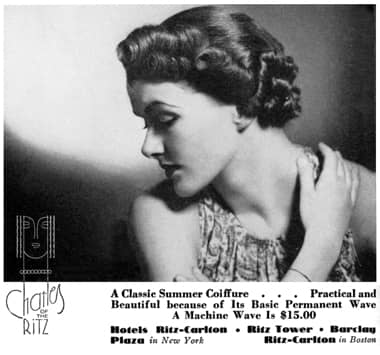
1936 Charles of the Ritz permanent wave.
